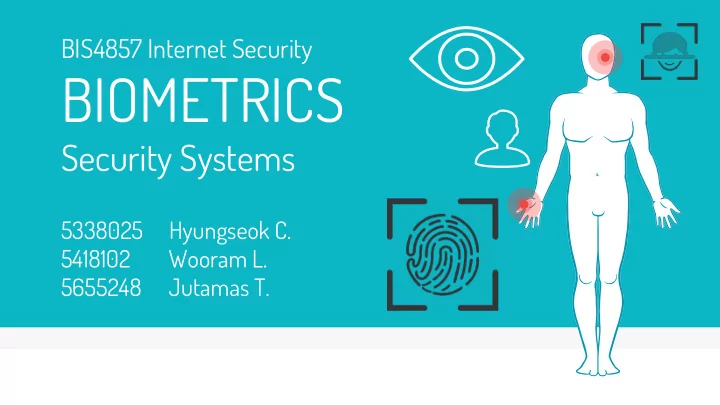

BIS4857 Internet Security BIOMETRICS Security Systems 5338025 Hyungseok C. 5418102 Wooram L. 5655248 Jutamas T.
CONTENTS ▹ What is Biometric Security System? ▹ Evolution of Biometric Security Systems ▹ Types of Biometric Security Systems ▹ Biometric Security System Advantages ▹ Biometric Security System Issues & Concerns ▹ Future of Biometric Security Systems
What is Biometric Security System?
What is Biometric System? Biometric come from the Greek words ▹ “bio” (life), ▸ and “metric” (to measure) ▸ Is unique physical and logical characteristics or traits of human ▹ body Biometric System Will collect all those biometric data and store in order to use ▸ for verifying personal identity.
Seven Biometric System Criteria Uniqueness The priority one requirement for biometric data ▹ Indicate how differently and uniquely the biometric system will be ▹ able to recognize each user DNA ▹ Universality Unique characteristics of each person in the world, which can’t ▹ replicated Retinal and Iris ▹
Seven Biometric System Criteria Permanence Every single characteristic or trait which is recorded in the ▹ database and needs to be constant for a certain period. ▹ Age of the user ▹ Collectability To verify their identification, allow to collection of each ▹ characteristics and trait in the system
Seven Biometric System Criteria Performance Outlines how well the security system works ▹ Accuracy and robustness ▹ Acceptability Choose fields in which biometric technologies are acceptable ▹ Circumvention decide how easily each characteristic and trait provided by the ▹ user can lead to failure during the verification process. DNA is most difficult to failure ▹
Evolution of Biometric Security Systems
Evolution of Biometric Security System One of the oldest and most basic characteristic of recognition is ▹ face. Since beginning of civilization, human had uses faces to identify ▹ known and unknown individuals.
Evolution of Biometric Security System During 1858, the first systematic capture of hand images for ▹ identification Recorded handprint of employees to distinguish employee's ▸ claim of payday During 1960, the first semi-automatic face recognition system ▹ System required the features as eyes, ears, nose and mouth on ▸ photograph
Evolution of Biometric Security System During 1986, Iris can be used for identification, ▹ which develop an algorithm to automate identification of the ▸ human iris. During 1991, the face detection was pioneered, ▹ by using eigenfaces techniques, the residual error could be ▸ used to detect faces in images.
TYPES of Biometric Security Systems
TYPES of Biometric Security Systems Fingerprint Recognition Face Recognition Iris Recognition Hand Geometry Voice Recognition Signature Verification
FINGERPRINT RECOGNITION Recognizes patterns on the fingerprint e.g. arches, whorls, and loops ▹ Most widely-used method ▹ Ergonomic, easy to use ▹ Can make mistakes when the finger skin is dry or dirty Uses: door locks, mobile phones
FACE RECOGNITION Recognizes features of the face e.g. eyes, nose, cheekbones, jaw edges ▹ Can scan static images ▹ Change in facial features ▹ Privacy abuse Uses: airport security, criminal identification
IRIS RECOGNITION Recognizes patterns in the iris e.g. rings, furrows, and freckles ▹ Accurate and very fast ▹ Intrusive ▹ Expensive Uses: airport security, border security, facility access control
HAND GEOMETRY Recognizes by width of fingers, width and thickness of palm ▹ Non-intrusive ▹ Relatively small storage ▹ Requires special hardware Uses: industrial environments, welfare agencies, immigration facilities
VOICE RECOGNITION Recognizes by voice e.g. pitch, speech patterns, speed ▹ Non-intrusive, popular ▹ Voice variation ▹ Background noise Uses: access control, banking, government offices
SIGNATURE VERIFICATION Recognizes by signature e.g. letter size, angles, strokes ▹ Easy to gather ▹ Non-intrusive ▹ Inconsistent signing Uses: financial transactions, e.g. purchasing with credit card
ADVANTAGES of Biometric Security Systems
ADVANTAGES of Biometric Security Systems ▹ Accurate Identification ▹ Difficult to forge or steal ▹ Convenient ▹ Reduce costs
Biometric Security Systems Issues and Concerns
Biometrics Issues and Concerns ▹ Privacy issues ▹ Ethical issues ▹ Technical issues
Privacy Issues ▹ Biometric data contains information acquired from individuals ▹ The place where biometric data is recorded
Ethical Issues ▹ User acceptance ▹ Concern the usefulness of some biometric devices
Technical Issues ▹ Concern the eye recognition ▹ Concern the voice recognition ▹ Software support
Future of Biometric Security Systems
Future of Biometric ▹ An Increase in Iris Scanning Within Security-Needy Industries ▹ Biometric Deployments in E-Commerce Will Skyrocket ▹ Wearables and IOT ▹ The Emergence of Smartphone Behavioral Biometrics
THANK YOU!
Recommend
More recommend